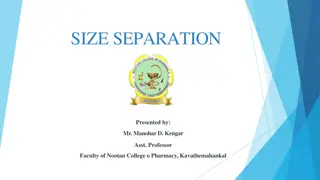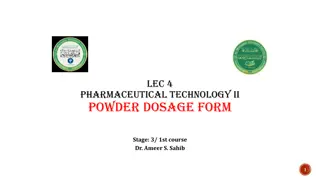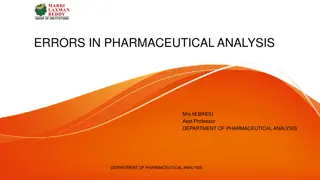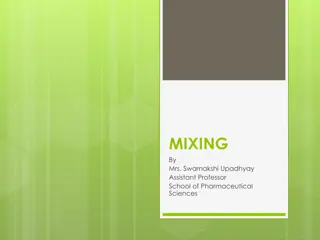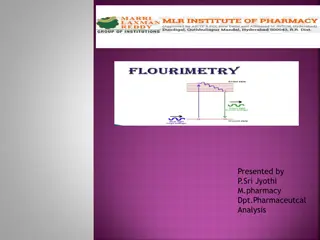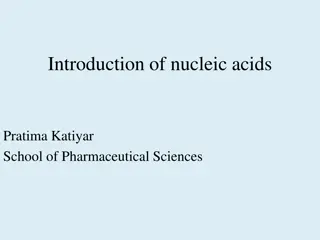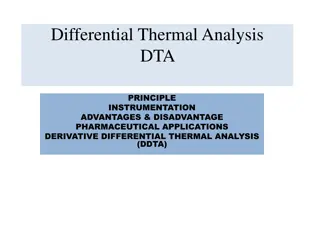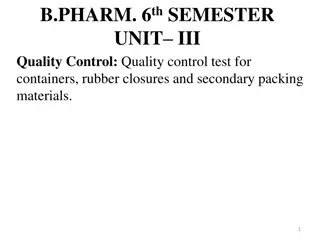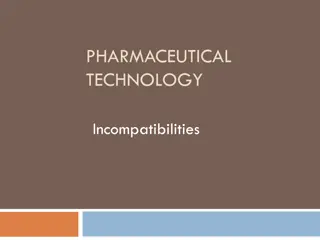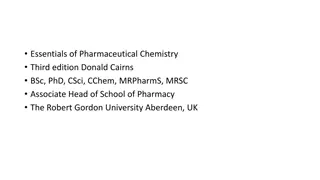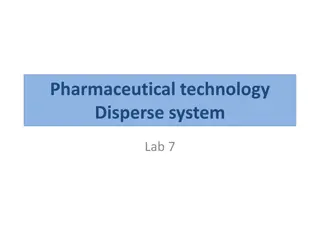Understanding IVIVC in Pharmaceutical Sciences
In the field of pharmaceutical sciences, In Vitro-In Vivo Correlation (IVIVC) plays a crucial role in predicting the relationship between in vitro dissolution rates of drug dosage forms and in vivo absorption rates. This correlation is essential for bioequivalence studies, reducing the number of trials required for approval, aiding in post-approval changes, and optimizing drug development processes. Levels of IVIVC, parameters for correlations, and regulatory significance are highlighted to emphasize its importance in ensuring drug efficacy and quality throughout the lifecycle.
Download Presentation

Please find below an Image/Link to download the presentation.
The content on the website is provided AS IS for your information and personal use only. It may not be sold, licensed, or shared on other websites without obtaining consent from the author. Download presentation by click this link. If you encounter any issues during the download, it is possible that the publisher has removed the file from their server.
E N D
Presentation Transcript
InVitro - InVivo Correlation Dr. Zafar Iqbal (TI) Department of Pharmacy University of Pesjawar
In vitro dissolution: Its a process of release of drug from dosage form as measured in an in vitrodissolution apparatus In vivo dissolution: process of dissolution of drug in the GI tract. Correlation: relationship between in vitro dissolution rate and invivo absorption rate as used in bio-equivalence guidance IVIVC has been defined as a predictive mathematical model describing the relationship between an in-vitro property of a dosage form and an in-vivoresponse
USP: the establishment of a relationship between a biological property, or a parameter derived from a biological property produced by a dosage form, and a physicochemical characteristic of the same dosage form. FDA: a predictive mathematical model describing the relationship between an in vitro property (usually the extent or rate of drug release) and a relevant in vivo response (eg, plasma concentration or amount of drug absorbed).
Significance of ivivc The main objective of developing and evaluating an IVIVC is to enable the dissolution test to serve as a surrogate. It reduces the number of bio- equivalence required for approval as well as during scale up and post approval changes (SUPAC). IVIVC shortens the drug development period, economizes the resources and leads to improved product quality. A means of assuring the bioavailability of active ingredients from a dosage form. Supports and or validates the use of dissolution methods and specifications IVIVC assists in supporting biowaivers.
Parameters for correlations IN VITRO INVIVO SL. No. 1. Dissolution rate Absorption rate (or absorption time) Percent of drug absorbed Maximum plasma concentration, Cmax Serum drug concentration, Cp 2. Percent drug dissolved Percent drug dissolved Percent drug dissolved 3. 4.
Levels of IVIVc The concept of correlation level is based upon the ability of the correlation to reflect the complete plasma drug level-time profile which will result from administration of the given dosage form. There are four levels of IVIVC that have been described in the FDA guidance, which include levels A, B, C, and multiple C
Level A correlation An IVIVC that correlates the entire in vitro and in vivo profiles has regulatory relevance and is called a Level A Correlation . This level of correlation is the highest category of correlation and represents a point-to-point relationship between in vitro dissolution rate and in vivo input rate of the drug from the dosage form.
Level A correlation is the most preferred to achieve; since it allows bio waiver for changes in manufacturing site, raw material suppliers, and minor changes in formulation. The purpose of Level A correlation is to define a direct relationship between in vivo data such that measurement of in vitro dissolution rate alone is sufficient to determine the biopharmaceutical rate of the dosage form.
Level B correlation Level B IVIVC is based on the principles of statistical moment analysis. In this level of correlation, the mean in vitro dissolution time (MDT vitro) of the product is compared to either mean in vivo residence time (MRT) or the mean in vivo dissolution time (MDTvivo). MRT, MDTvitro and MDTvivo will be defined throughout the manuscript where appropriate.
A level B correlation does not uniquely reflect the actual in vivo plasma level curves, also in vitro data from such a correlation could not be used to justify the extremes of quality control standards hence it is least useful for regulatory purposes.
Level C correlation Level C correlation relates one dissolution time point (t50%, t90%, etc.) to one mean pharmacokinetic parameter such as AUC, tmax or Cmax. This is the weakest level of correlation as partial relationship between absorption and dissolution is established since it does not reflect the complete shape of plasma drug concentration time curve, which is the critical factor that defines the performance of a drug product
Due to its obvious limitations, the usefulness of a Level C correlation is limited in predicting in vivo drug performance. In the early stages of formulation development. Level C correlations can be useful when pilot formulations are being selected while waiver of an in vivo bioequivalance study (biowaiver) is generally not possible.
Multiple level C correlations This level refers to the relationship between one or more pharmacokinetic parameters of interest (Cmax, AUC, or any other suitable parameters) and amount of drug dissolved at several time point of dissolution profile. Multiple point level C correlation may be used to justify a biowaivers provided that the correlation has been established over the entire dissolution profile with one or more pharmacokinetic parameters of interest.
A multiple Level C correlation should be based on at least three dissolution time points covering the early, middle, and late stages of the dissolution profile. The development of a level A correlation is also likely, when multiple level C correlation is achieved at each time point at the same parameter such that the effect on the in vivo performance of any change in dissolution can be assessed.
Level D correlation It is not a formal correlation but it is a semi quantitative (qualitative analysis) and rank order correlation and is not considered useful for regulatory purpose but can be serves as an aid in the development of a formulation or processing procedure.
IVIVC Models The relationship of observed drug concentration-time profiles following administration of a tablet/capsule with drug dissolution and pharmacokinetics may be described graphically.
Level A B In-Vitro Dissolution curve Statistical dissolution time (MDT) In-VIVO Input (absorption) curves Statistical moments: mean residence time (MRT), mean absorption time (MAT), etc Maximum observed concentration (Cmax), observed at time (Tmax), absorption constant (Ka), Time to have 10, 50, 90% absorbed, AUC (total or cumulative) moments: mean C Disintegration time, time to have 10%, 50%, 90% dissolution rate, efficiency (DE) dissolved, dissolution A: one-to-one relationship between in vitro and in vivo data, e.g., in vitro dissolution vs. in vivo absorption B: correlation based on statistical moments, e.g., in vitro MDT vs. in vivo MRT or MAT C: point-to-point relationship between a dissolution and a pharmacokinetic parameter, e.g., in vitro T50% vs. in vivo T max, Multiple C: relationship between one or several PK parameters and amount dissolved at several time points.
Evaluation of IVIVCs by different levels was first proposed for oral dosage forms in the USP s information chapter and was later adopted globally. Presently, IVIVC is categorized by the FDA into levels A, B, C, and Multiple C depending upon the type of data used to establish the relationship and ability of the correlation to predict the complete plasma profile of a dosage form.
In vitro-in vivo correlation (IVIVC) the correlation between in vitro drug dissolution and in vivo drug absorption
Purpose of IVIVC The optimization of formulations may require changes in the composition, manufacturing process, equipment, and batch sizes. In order to prove the validity of a new formulation, which is bioequivalent with a target formulation, a considerable amount of efforts is required to study bioequivalence (BE)/bioavailability(BA). The main purpose of an IVIVC model to utilize in vitro dissolution profiles as a surrogate for in vivo bioequivalence and to support biowaivers Data analysis of IVIVC attracts attention from the pharmaceutical industry
Purpose of IVIV Studies The main purpose of an IVIVC model to utilize in vitro dissolution profiles as a surrogate for in vivo bioequivalence and to support biowaivers Data analysis of IVIVC attracts attention from the pharmaceutical industry
Input/Edit In Vivo Absorption Data: IV, Oral solution or IR drug Develop an IVIVC Model: Fitting IV, Oral solution or IR drug Input/Edit In Vivo Absorption Data: IV, Oral solution or IR drug








